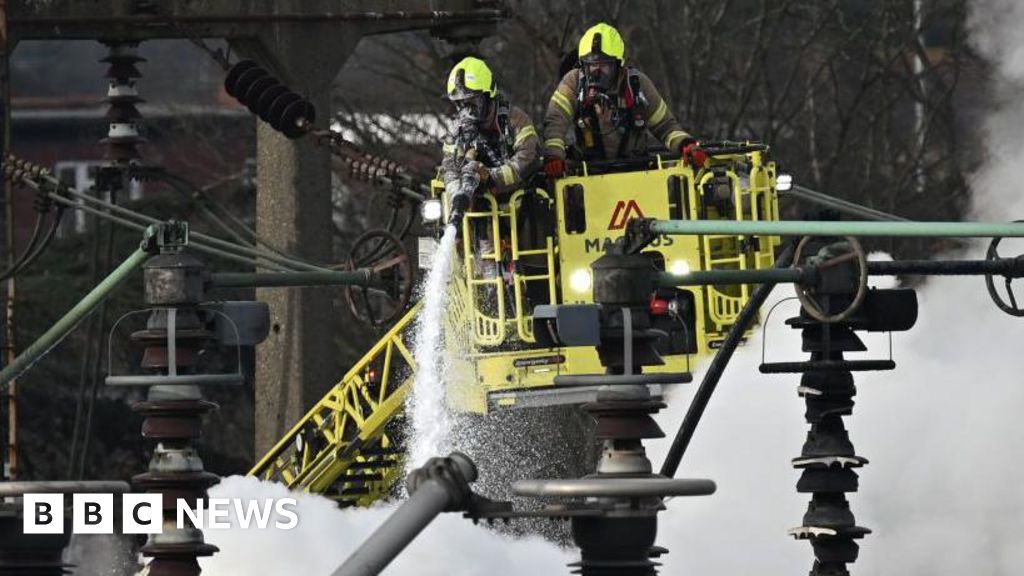A report into a fire at an electricity substation that resulted in Heathrow Airport shutting down for nearly a day, causing chaos for more than 200,000 passengers, has been released. The National Energy System Operator (NESO) identified the likely cause of the fire, and said that National Grid which operates the substation was warned about a fault seven years ago. Here are five key findings from the report. The NESO report answered one of the key questions – what caused the fire? The device which caught fire was a "supergrid transformer", which takes high voltage electricity from the transmission grid and reduces it to a lower voltage for the next stage of its route to Heathrow Airport and surrounding houses. Inspectors said the likely cause was moisture getting into the high-voltage "bushing" – insulation around the connections. That caused a short-circuit and "arcing" - electric sparks like those in a spark plug - which resulted in a "catastrophic failure". That caused the oil which is used to cool the transformer to catch fire, and took two transformers offline, cutting power to Heathrow. The report said signs of moisture were detected at North Hyde in July 2018. National Grid's guidance said these were "an imminent fault" that should be replaced. But the issue wasn't fixed at the time. In 2022, basic maintenance on the transformer was deferred. Multiple further attempts were made to schedule maintenance, but none went ahead. Heathrow uses as much electricity as a small city, and it has three connections to the national grid. But it new that if one of them went down, it would have to close the airport for 10 to 12 hours while key systems were connected to the other sources of supply. It did not think it was a likely scenario, so it was not considered worthwhile to spend the money to fix it – which Heathrow has previously said would have cost a billion pounds. NESO said having three connections to the grid meant there were "opportunities" to improve Heathrow's resilience of supply. National Grid and the energy supplier SSEN knew that electricity from North Hyde went to Heathrow Airport. But they did not know that Heathrow would have to shut down if that supply was interrupted. Perhaps if they had, they would have taken a different approach to maintenance. Energy suppliers do not currently know if their customers are counted as "critical national infrastructure (CNI)" – sectors such as transport, defence, government or communications. The report calls better communications between CNI operators and their energy suppliers to ensure that supplies do not get interrupted. Heathrow came under a lot of criticism after the fire - including the revelation that the chief executive Thomas Woldbye was asleep in bed when the decision was taken to close the airport. NESO said its report was not written to "apportion blame", but Heathrow says it is now considering legal action against National Grid. In its view the report described "clear and repeated failings" which "could and should" have prevented the fire. It said it expected National Grid to "take responsibility for those failings." National Grid said it had a comprehensive maintenance programme, and would co-operate closely with the Ofgem investigation.
Five takeaways from report into fire that shut Heathrow down
TruthLens AI Suggested Headline:
"NESO Report Reveals Causes of Fire Leading to Heathrow Airport Shutdown"
TruthLens AI Summary
A recent report by the National Energy System Operator (NESO) has shed light on the fire that caused Heathrow Airport to shut down for nearly a day, impacting over 200,000 passengers. The NESO identified that the fire originated from a malfunctioning supergrid transformer, which is responsible for converting high voltage electricity from the transmission grid to a lower voltage suitable for distribution. Inspectors concluded that moisture ingress into the transformer’s high-voltage bushing led to a catastrophic failure, manifesting as a short-circuit and arcing. This resulted in the transformer oil igniting and subsequently took two transformers offline, cutting off power to the airport. Alarmingly, signs of moisture had been detected back in July 2018, and despite guidance recommending immediate replacement, the issue remained unaddressed. Additionally, maintenance scheduled for 2022 was deferred, further exacerbating the risk of failure. Heathrow, which relies on as much electricity as a small city, had three connections to the national grid but did not anticipate the need for a contingency plan if one connection went down, leading to the decision to defer costly repairs estimated at one billion pounds.
The report highlighted significant communication gaps between energy suppliers and critical national infrastructure (CNI) operators like Heathrow. Although both National Grid and the energy supplier SSEN were aware that electricity from the North Hyde substation supplied power to Heathrow, they did not understand the implications of a power interruption. This lack of awareness may have influenced their maintenance strategies. The NESO report did not assign blame but emphasized the necessity for improved communication to prevent future disruptions. In the aftermath of the incident, Heathrow faced criticism, particularly regarding the fact that its CEO was reportedly asleep when the airport's closure decision was made. In response to the report's findings, Heathrow is contemplating legal action against National Grid, asserting that the report indicated repeated failures that could have been avoided. National Grid, on the other hand, maintains that it follows a comprehensive maintenance program and is committed to cooperating with the ongoing investigation by Ofgem.
TruthLens AI Analysis
You need to be a member to generate the AI analysis for this article.
Log In to Generate AnalysisNot a member yet? Register for free.
